Menu
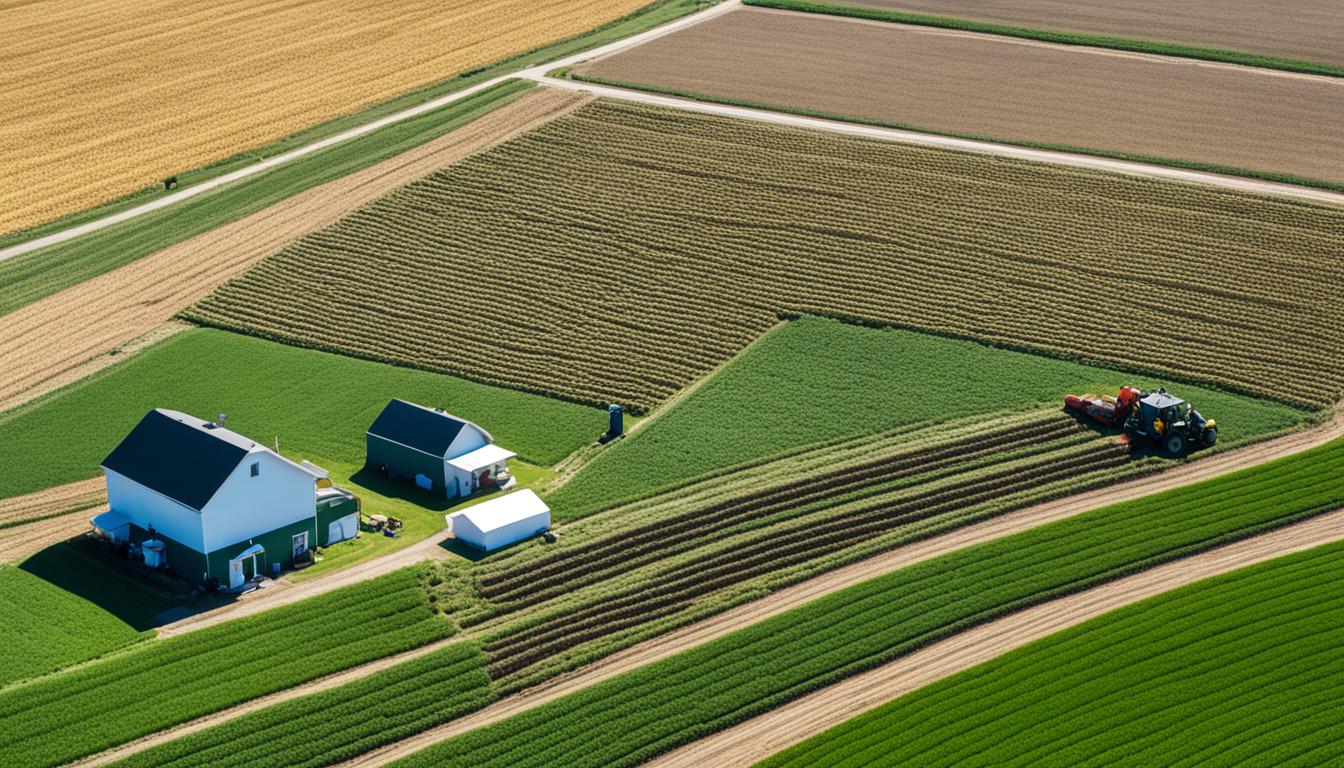
Did you know, around 52 percent of U.S. land is used for farming? This shows the big connection between environmental laws and farming rules, especially for small farms. An in-depth study checked how each state did economically from 1982 to 1992 with different environmental rules. It found that small farms didn’t really suffer from tough environmental laws. This might seem unusual since many believe strict rules could hurt a farm’s ability to make money. This study suggests we need to think more about how rules and farm success are connected.
Agriculture today faces important choices due to many environmental rules. These rules aim to make farming last longer and to protect nature. They include rules about using the land and strict checks on environmental standards that farms must meet. For a long time now, important laws like the Clean Water Act have changed how farms look after the environment.
The EPA has tried to help rural areas grow but some rules have been criticized as too tough on farmers. Many of these rules come from the EPA but it’s the local and state governments that make sure farms follow them. Farmers worry most about the rules on air and water quality. They aim to reduce pollution from farming that can harm the air we breathe and the water we drink.
Farms with many animals have even more rules to follow, which makes things even harder. The push for more green energy, like making biofuel from corn, is adding to the farmers’ challenges. The use of pesticides is also tightly controlled to protect people and nature from harm.
Surprisingly, while big factories used to be the main targets of environmental rules, now farmers face their own share. These farming rules are mostly voluntary but they offer rewards for taking good care of the land. This system shows how balancing nature’s needs with the need to make a living is key for farmers, big and small.
A recent study from China showed how these rules can lead to better farming without hurting incomes. The research found that strict environmental rules help farms grow better. These rules seem to work even better for families with higher earnings.
So, making wise environmental rules is very important. We should create strong support for managing the land well and making sure farmers earn enough. As these rules change and grow, they will keep affecting how farms around the world run and make money.
Environmental laws have greatly influenced farming, especially small farms. These laws have changed how farmers take care of their land. Agricultural policy and laws have brought big changes to the farming world.
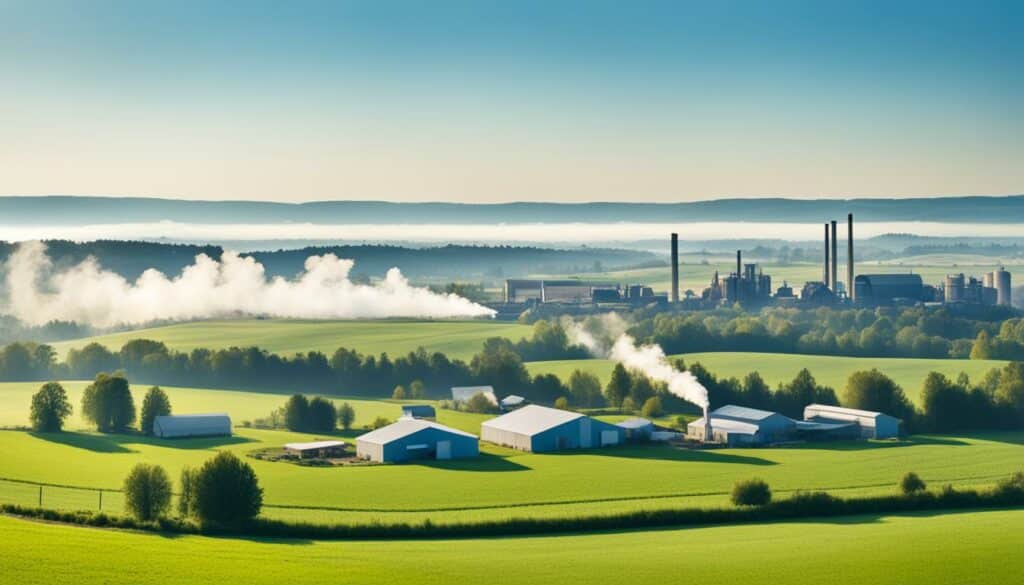
Looking back, policy has had a big impact on farm practices. For example, from 1925 to 1930, farming methods destroyed 33 million acres. The 1993 Agricultural Law in China was a key moment, aiming to reduce farm pollution. This inspired global efforts. In the 1930s, severe dust storms showed the effect of harming the environment. 200 million trees were planted to fight this from Canada to Texas, showing the urgent need for action.
Small farmers found it hard to adjust to the new rules. Some welcomed the changes, working hard to improve how they care for the land. Others found it too expensive. After a severe drought in 2012, the value of farmland went up. This hit small farmers hard. The High Plains are still facing a very severe drought today, showing these challenges continue.
| Year | Event | Impact |
|---|---|---|
| 1932 | 14 Dust Storms | Initial recognition of severe environmental issues |
| 1937 | 72 Dust Storms | Peak of environmental degradation |
| 2012 | Worst Drought in 50 Years | Increased farmland values |
Environmental laws are always changing, affecting farms, especially small ones. They show the fine line between environmental legislation and small farm problems.
Small-scale farming must be able to make money over time to stay afloat. It faces tough market changes and rules. These challenges are especially hard for small farms. So, knowing about important financial points is key.
Economic viability means the farm can support itself financially. It needs to balance costs with what it makes. Things like the quality of the land and how resources are used are vital. The USDA National Commission on Small Farms says these farms are very valuable. They do good for communities and the environment. Still, they are under pressure from high rule costs and changing market prices.
Looking closely at certain financial areas is crucial. These things help figure out if a small farm can make it. The main points to watch are:
These check points are very important. They help see if a farm is doing well enough. Even though small farms can be very productive, they still have big challenges. For example, how they use their land can really boost their output. But, they face tough market pressures and competition from global markets.
| Indicator | Description | Impact on Viability |
|---|---|---|
| Profitability | Net income after all expenses | Ensures sustainability |
| Production Costs | Total operational and compliance costs | Influences net profit |
| Income Stability | Consistency of income over time | Reduces financial uncertainty |
Small farms need to keep an eye on these financial points. They determine if a farm can last and grow. The journey is hard, but with good plans, small farms can stay strong and keep up with the competition.
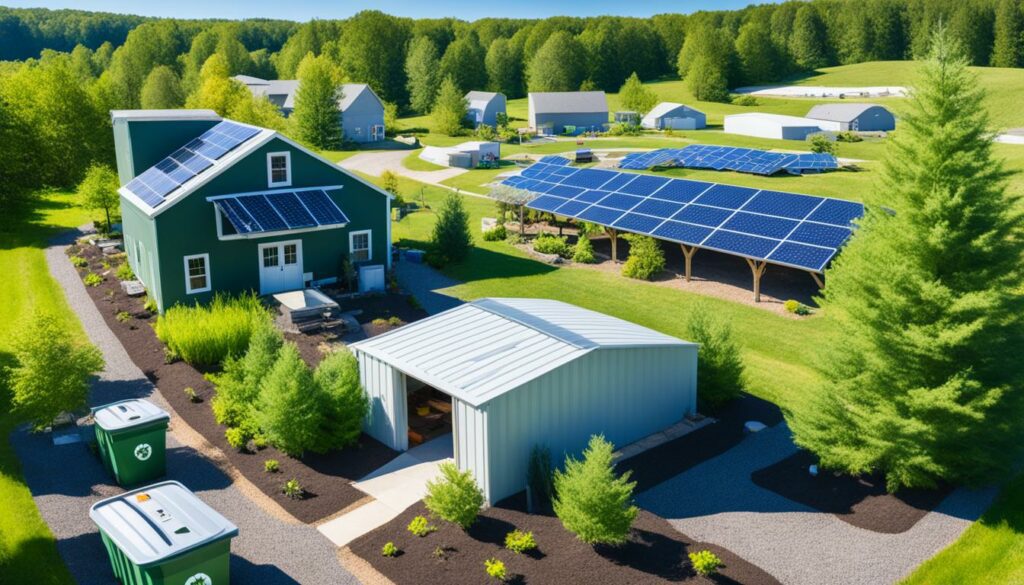
Today, environmental rules are getting stricter, and small farms must keep up. They must use methods that cut pollution and save nature. This includes using fewer chemicals, stopping soil erosion, and buying advanced equipment to reduce pollution.
Small farms face a big issue: the costs. They may have to spend a lot on new technology or pollution control. For example, they might need to make soil and water conservation systems which are expensive. This could be tough for them.
Adjusting their current methods to meet these rules also costs money. They might have to change how they grow things or update their land. Keeping up with the costs of following these rules is hard because they have less money to spend.
This change might at first lower the amount of crops they produce. For instance, using less chemicals at first could mean they grow less. Till they find a way to do it right, making money while following these rules is tricky.
The government is trying to help by making laws like the Rural Prosperity and Food Security Act of 2024 (RPFSA). This law aims to support small farms. But, there’s still a big need for more help to cover the costs and keep these farms going strong.
| Compliance Activity | Initial Cost | Annual Maintenance Cost | Pollution Reduction |
|---|---|---|---|
| Soil Erosion Control | £5,000 | £500 | High |
| Chemical Input Reduction | £3,000 | £300 | Moderate |
| Water Conservation | £7,000 | £700 | High |
It’s clear small farms need a lot of help to follow these rules without going broke. What they really need are rules that help them meet high environmental targets and money help. This way, small farms can do their part for nature while still making a living.
Marginal lands are key in sustainable farming because they are not very productive but are sensitive to the environment. Economic changes and policies often lead to how these lands are used. They are central to land-use changes based on different world factors.
How marginal lands are used depends greatly on the economy and rules in place. The Conservation Reserve Program (CRP) paid farmers big money in 2005 to not farm an area almost as big as Iowa. This shows how green policies can shape what we do with land. The aim of this program is to let sensitive lands have a break, helping nature and farming last in the long run.
After a law in 1994, there were more benefits for crop insurance. By 1997, one more % of farmland was used for crops. This new land wasn’t very good for growing things. It shows that financial help and laws can change how we farm.
Marginal lands are important because they are at risk of erosion, losing nutrients, and flooding. In 1997, about 25% of farmland that was used a lot was in danger of erosion. But, after the insurance change, 33% of new farmland had big risk of erosion. This new land often included wet areas that were farmed before, making the environmental danger go up.
Using these sensitive lands needs careful handling to avoid eco and money issues. The CRP lands usually leak less nitrogen and phosphorus compared to land farmed normally. This means green policies help keep this land fertile and less risky for the environment in the long term.
Clearly, marginal lands can do a lot for sustainable farming under the right green rules. Proper use and care for these lands can offer both profit and protect the environment.
Government support is key in making agriculture more eco-friendly and economically sound. The Conservation Reserve Program (CRP) and the Federal Crop Insurance Program are vital. They guide farmers, especially those with small farms, to choose better practices.
The CRP is vital for eco-friendly farming. It encourages farmers to take certain lands out of farming. This helps the environment and keeps our ecosystems stable.
Cover crops like rye and clover help with weed control and improve soil. Farmers in the CRP get paid for not farming these lands. This money helps when they can’t use their fields.
The program picks the best lands for this non-farming. It uses bids to choose the lands that need it most. This ensures the program helps where it’s most beneficial.
Methods like strip cropping and no-till farming stop soil erosion. So, the CRP does a lot to protect our land and water.

The Federal Crop Insurance Program helps farmers grow crops by lowering insurance costs. This is good when bad weather or market changes hit. However, it might encourage farming lands that could be better left wild.
Unlike the CRP, this program doesn’t focus on giving up some lands for the environment. It aims to keep farmers farming. This decision can be tough for small farmers. They have to balance profit with looking after the land.
“The use of Integrated Pest Management (IPM) in conjunction with these government programs can significantly reduce economic, health, and environmental risks.”
Both the CRP and the Federal Crop Insurance Program have their place. They help us see the challenges in farming in a sustainable way. Farmers need to consider the effects on their finances and their land’s health.
Small farms all around the world are finding it tough to deal with strict environmental rules. These rules hit hard on their finances and operation ways.
Small farms worry a lot about the money laws cost. They have to spend a lot to get the right gear and tech. Such as, keeping pollution down is much harder for these farms, which ends up costing them even more. This extra cost shows up in a few ways:
Though they’re for good reasons, these costs stretch small farms thin.
Small farms have to change how they work a lot to follow the rules. They need training for new ways to grow things. This can slow down how much they get done. Here are some changes they might make:
These changes help make small farms stick around. But they often lower how much they make now. It’s hard for them to keep making money and do what’s right for the planet. Even though small farms do a big part in feeding the world, following new environmental rules is not easy for them.
Environmental rules hugely impact little farms right from the start. They touch on how much money farms make and their chance of long-term survival. It’s important to look at how these rules affect small agricultural businesses.
Starting to follow environmental laws can cost small farms big. They have to spend money on new gear, buildings, and maybe change how they farm. In 2005, the Conservation Reserve Program (CRP) gave almost $1.7 billion to farmers. They were paid to not farm an area almost as big as Iowa. This money helps the environment but can hit small farms hard. This is because they need to keep producing to make ends meet.
Farms of different sizes find it costly to join these schemes. The FDA says that very small farms might pay almost $4,500 a year, and the bigger ones, over $29,000. These costs can eat up a huge part of a farm’s earnings, especially if they sell less.
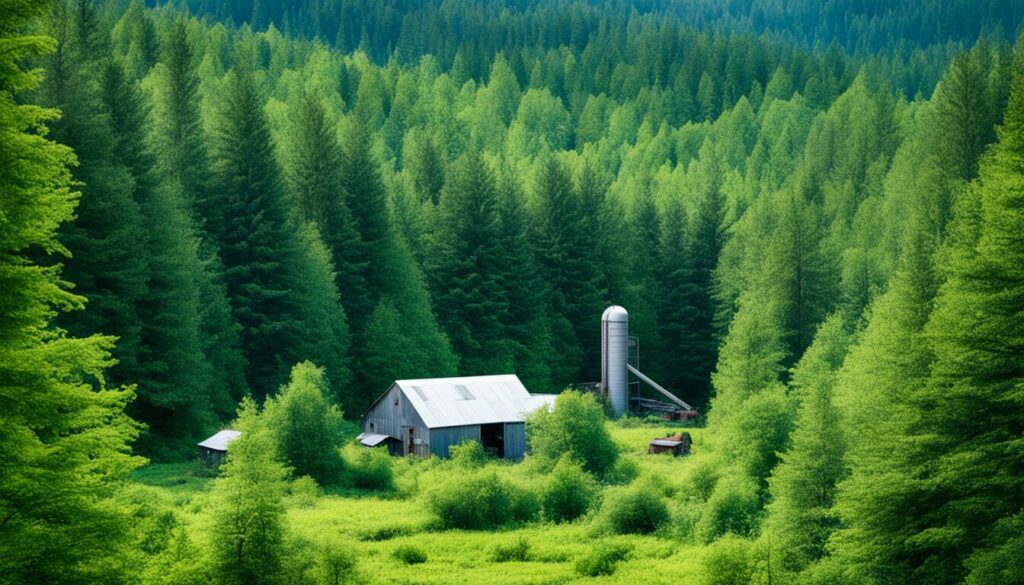
From 2000 to 2003, more and more farms got insured. By 2003, insurance covered 60% of the farmable land. This shows how much these farms need federal help to keep their doors open despite environmental rules.
Over time, environmental laws can help or harm small farms. For example, the CRP can help in the long run by saving less productive lands. Yet, it might change how land is used, which can be good or bad.
Between 1982 and 1997, lots of farming land changed in its use. Most of these lands had soil not as good as the average. It’s clear we need to be careful changing how we use land. Bad choices could hurt the soil and the farm’s future. After more insurance help in 1997, a third of new farmed lands were at risk of easily washing away, which could hurt farming later on.
In the future, looking after water will be key for small farms. By 2040, there could be 20% less water in some farming areas. This would make it hard for smaller farms to keep going. About 20% of these farms already have very little water available. This makes it even harder for them to run.
These rules have a big effect over a long time. We need to look at both immediate financial effects and long-term consequences. A careful plan is vital. It will keep small farms able to make a living under these changing rules.
Real-life stories show how small farms deal with laws about the environment. These stories have both good and rough parts, showing how the rules affect them.
Small farms have learned to grow despite many rules. Places like Sub-Saharan Africa, Asia, Mexico, and Colombia show that small farms use their land very well. They are very efficient because they use their space and resources smartly. Medium-sized farms that use just a few workers are very good at what they do too. This shows that being the right size and managing well can make these farms do better.
In the Northwest, small farms are vital. They make up 8.3% of all sales and 7.5% of jobs locally. Places in Oregon and Washington have more small farms, which means they have more local jobs and businesses. They also play a big part in the area’s community events. Since these places produce a lot of apples and cherries, it shows how important small farms are for the economy.
The stories also reveal tough challenges. Like in Washington, a drought in 2015 hurt farmers a lot, costing millions of dollars. Most big crop losses and insurance payments in the Northwest come from bad weather. This puts small farms at risk and shows they need more help.
Trade policies can be bad for small farms too. In the U.S., small farmers face a tough time, especially when they make less than $250,000 a year. In 2021, extreme heat made some farmers lose nearly all their crops. A lack of workers has hurt, causing billions in lost crop sales.
Small farms have to work hard to stay afloat. They focus on quality and try to keep their workers happy. But, the main idea in these stories is that while small farms really take care of nature, they face serious threats from the environment and money problems.
| Region | Challenges | Success Stories | Policy Impact |
|---|---|---|---|
| Sub-Saharan Africa, Asia, Mexico, Colombia | Resource limitations, climate variability | Higher productivity, land-use efficiency | Higher total factor productivity |
| Northwest U.S. | Drought, extreme weather events | Local businesses, higher employment | Economic contributions, agricultural sales |
| Washington, Oregon, Idaho | Crop losses from heat, trade pressures | Leading producers of apples, cherries, potatoes | Significant local employment, stronger community engagement |
It’s key for small farms to mix sustainability with making money. This mix helps them grow even with strict green rules. With nearly 10 billion people to feed by 2050, we need to make 70% more food. So, we must find ways that protect nature and allow profit.
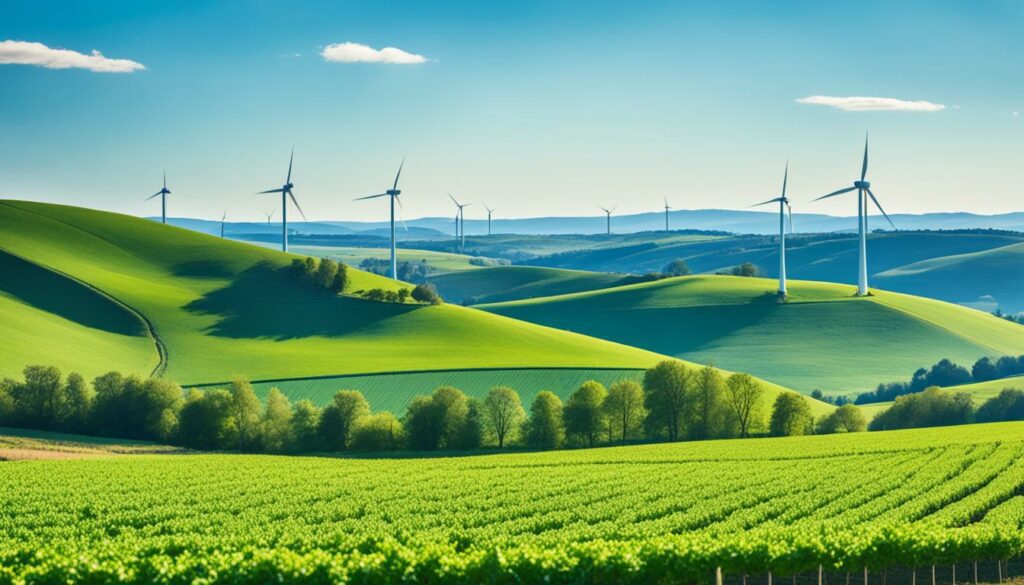
For small farms, being green and profitable means using smart farming. They must care for the land with things like soil care, changing crops, and going organic. Looking after the soil prevents it from washing away and keeps plants healthy. Changing crops helps the soil stay rich, uses less nutrients, and stops bugs and diseases. Plus, organic farming – which shuns chemicals – is great for the planet, cutting down on pollution and protecting wildlife.
Farms can keep on making money while staying green by doing a few things. One is to find new ways to earn cash, like growing food in cities or focusing on plant foods. These choices are more about survival today. Also, joining initiatives like Plug and Play’s Agtech platform opens the door to new business chances and funds. This support can help them stay economically sound.
Another way is by using resources better. High-tech farming methods can make things more efficient, saving money and growing more food. Also, taking part in schemes like the Conservation Reserve Program can give them a financial leg-up for going green.
Mixing green goals with keeping the budget in check is crucial. Doing so not only protects the environment but also boosts local economies and saves money. Since more than a billion people make a living through farming, balancing green farming with profit is crucial. It ensures farms can keep going for years to come.
Technology is key in lessening the economic effect of eco rules on small farms. Green tech helps them do better for the planet and save money. It’s worth looking at the tech that’s changing how farms run.
Green tech is changing farming. Drones give farmers detailed info on soil and crops. This helps farmers use water better and improve their crops.
Artificial Neural Networks are a big deal too. They’re great at guessing how much crop farms will produce. In Mexico, they’ve helped farms make more, while spending less.
And, there are more solar panels and wind turbines on farms. These techs cut down on pollution and save on energy bills. This makes farming more profitable.
For small farms, affordable solutions are vital. Precision agriculture means using water, fertilisers, and pesticides just where they’re needed. This saves money and helps the planet.
Turning waste into useful things is also smart. Farms can use old crops to make compost or energy. This both saves money and helps meet green rules.
AI is a big step forward, too. An EU project is using it to help pick the best seeds. This means better crops and less worry about market changes.
The OECD really pushes for using more tech in farming. A big talk was held in the Netherlands in 2000 on this. It showed how tech boosts farming while helping the environment.
Using these green technologies and smart solutions, farms can cut compliance costs. This helps them stay in business, even with strict environment rules.
Helping small farms stay afloat in the face of tough environmental rules needs key steps. There are two big parts to this: giving them financial help and tweaking the rules.
Giving small farms money help is big. Things like grants and tax breaks make sticking to environment rules easier. For example, helping them buy tech that saves water can offset the loss of farmland by 2040. In the San Joaquin Valley, farms of 10-50 acres need a lot of water for crops. So, aiding them with water-saving tech is vital.
Setting up special funds for better use of water underground is key, too. About 20% of small farms struggle with little to no water above ground. This change would let these farmers keep up with green methods.
Changing the rules is also essential for small farms. They benefit from softer rules and more time to follow them. For instance, small farms will need a lot of water for crops. By spacing out how they comply with these rules, we avoid big losses in farm sizes.
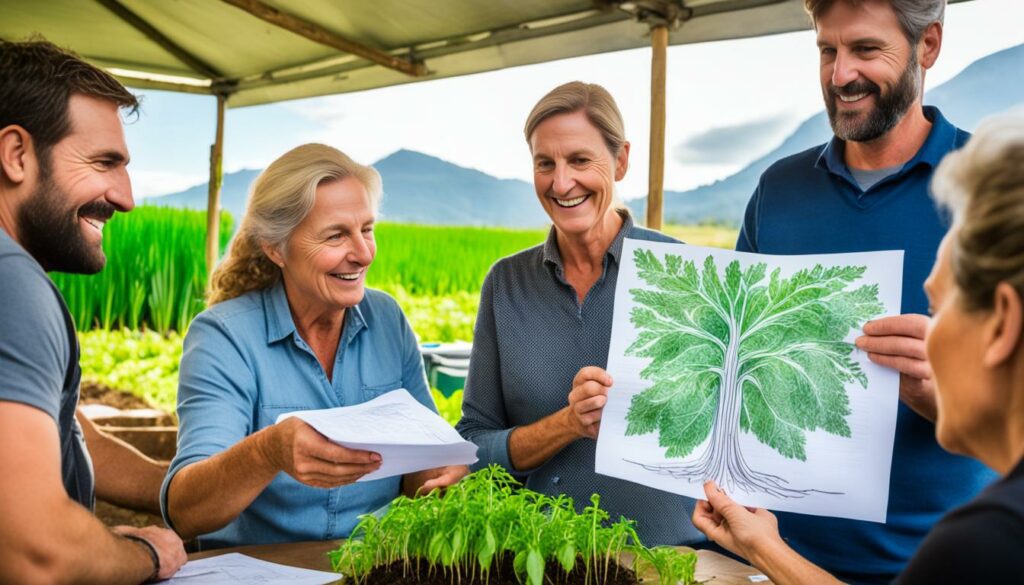
This table below highlights the water needs and shows where tweaked rules and extra funding could help:
| Farm Size | Current Surface Water (af per acre) | Water Requirements (af per year) | Potential Acreage Reduction Without Adjustments |
|---|---|---|---|
| Below 10 acres | 2.2 | 180,000 | 13% |
| 10-50 acres | 2.2 | 1 million | — |
| 2,000-plus acres | 1.5 | — | 22% |
Making sure these policies support both farm finances and the environment is key.
The world of farming is changing, moving towards eco-friendly and sustainable ways. This change is happening thanks to new tech and policies that mix green ideas with making money. To keep up, small farms need to know about these new directions.
Exciting new tech is leading the way in green farming. Things like bio-farming, growing crops without soil, and using high-tech devices to manage crops are making farming cleaner and smarter. Thanks to tools like GPS and sensors, farmers can use water and nutrients exactly where they’re needed. This reduces waste and keeps the soil healthy.
The future’s policies are aiming to make farms both eco-friendly and profitable. For example, the EU is setting up rules to encourage green farming combined with smart business practices. They want farms to work with different experts, do new research, and come up with cool farming ideas.
There’s also a big focus on saving water, especially in dry places like California. Expect to see more about using less water, but still growing crops well.
“Agricultural productivity soared post-WWII due to new technologies, mechanisation, and increased chemical use, proving the transformative power of innovation in this sector. As we move forward, integrating sustainable practices with emerging technologies will be key to meeting the demands of future generations.” – Agricultural Expert
Looking ahead, it’s clear we need to think about farming as a whole system. This means mixing biology (the study of living things), economics (how we use money), and engineering (making mechanical things). Mixing these areas is key to making farming both green and profitable. New rules should make it easier to try out new things and to find a good balance between making money and caring for the environment.
Small farms face challenges balancing farm life and making money. Big farms are efficient and cheap but can harm the environment a lot. They often pollute waterways. Buying local can help, as it cuts down on transport that pollutes.
People think small farms are slow and not as good. But, they can grow food that’s better for us and the planet. All farms should work to be more green. In places like China, they show that changing how we farm can cut carbon and help the Earth.
For small farms to do well, they need rules that are fair and help them grow. These rules should protect nature but also consider the farm’s costs. By looking at stories from around the world, we see that laws made just for small farms can lighten their load. They make farms greener and still keep them in business. This is key to a healthy farming future.
Environmental rules push up the costs for small farms to follow them. This means spending more on tech and changing how things are usually done. It’s tricky for these farms to stay afloat and make money while keeping up.
The rules around farming, like subsidies and laws, really matter for small-scale farms. They can help these farms stay strong and grow, or they could make things really hard.
Sustainable farming means growing food now that won’t stop others from doing the same in the future. It’s key for making sure we have food, our planet doesn’t suffer, and farms make money.
Land changes from the past, especially on less productive areas, hit small farms hard. These shifts can make farming less efficient, harm the environment, and change the money side of things.
The Clean Water Act and Clean Air Act changes in the US are big examples. Laws like China’s 1993 Agricultural Law also matter. These rules have encouraged farming to be more eco-friendly.
For small farms to be economically viable means they make enough money. They need to cover costs, make profits, and keep their income steady to stay in the game.
Making farms greener can cost a lot. You might need to buy new green tech, change how you do things, and budget for keeping up with rules. These are tough for smaller farms that don’t have much to spend.
Fields that aren’t very good for farming are important. If you manage them well with the right policies, you can stop soil erosion and keep the land’s nutrients. This helps keep agriculture sustainable.
The Conservation Reserve Program (CRP) and Crop Insurance are there to help. CRP pays small farms to give a break to land that needs it, and crop insurance makes sure farming can go on.
Meeting the green rules can mean big costs and changes in how you farm. This puts a lot of pressure on a farm’s money and long-term chance of success.
In the short run, keeping up with rules and investing in green can hurt a farm’s wallet. In the long run, it may mean shifting how farming is done, for better or worse.
Many small farms have shown they can do well by being eco-friendly and innovative. They prove that despite the rules, you can still make a living farming smart.
To do well, small farms should do good by the environment and find different ways to make money. They should use resources wisely and work with the government where they can.
Tech can help lower the cost of being green. Things like precision farming and clean energy not only help the planet but also save on running a farm.
To aid small farms, governments can offer tax breaks and money to help with green rules. Also, making some rules a bit easier to meet or giving more time can really help.
The future of farming seems exciting with new tech and ways to farm. Policies will focus more on helping innovation, making rules clear, and combining environmental and economic aims.